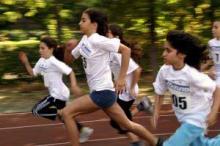
Endurance is defined as the ability to continue despite fatigue or difficult conditions.1 The stamina to perform physical activities for longer periods of time can be improved by exercise and increasing the amount of activity. This will result in developing stronger muscles, reducing body fat, and lessening the risk of developing diabetes or high blood pressure.2
The ability of a muscle group to sustain contractions over an extended period of time is called muscle endurance. Mountain climbing, tug-of-war, and wrestling are examples of continuous tension activities that require the muscles to remain contracted for an extended amount of time. Running, biking, swimming, skating, and rowing are examples of repetitive dynamic contraction endurance that require a muscle to repeat a contraction over an extended period of time. Activities that require prolonged intense contractions with short resting periods are football, hockey, and handball.3
It is recommended that children have at least 60 minutes of moderate exercise daily. A combination of planned and unplanned activities will aid the child’s overall health, whether the source of exercise is playground activities, free play, physical education classes, or games.4
Playground equipment, such as overhead ladders and monkey bars, offers opportunities for children to improve their upper body strength and endurance.5 Today’s playground manufacturers are designing innovative structures that engage children in challenging activities, such as climbing rock walls and nets, hanging from overhead gliders, and brachiating on overhead rings.
Increasing endurance and strengthening the lungs and heart rate in children is achieved by regular aerobic exercise. Riding a bike or walking to school is a great source of aerobic exercise for many children as well as running, playing tag, and jumping rope. Because of the buoyancy of the water supporting body movements, swimming provides a great workout for children with conditions such as asthma, obesity, and juvenile diabetes.6
School physical education programs realize an important key to increasing aerobic endurance is having a variety of activities.7 The young child’s neuro-muscular system is capable of general movement skills as well as sport specific techniques. However, their interest drops in a particular exercise rapidly and is followed by sloppy performance of that particular skill. Changing the activities frequently will keep children engaged and extend their ability to continue the exercise which will add to their endurance.8
Children have many programs offered to them that will increase endurance, agility, and strength, such as wrestling, gymnastics, and dance classes.9 Soccer, Little League Baseball and Softball, and the Pop Warner football, cheer and dance programs all offer organized team participation for children as young as 5 years of age.
- 1. “Endurance.” Dictionary.com. < www.dictionary.com > 30 July 2010.
- 2. Welton, Rose. “Endurance Exercises for Children.” Livestrong.com. < http://www.livestrong.com/article/107412-endurance-exercises-children/ > 30 July 2010.
- 3. Mercer, Lisa. “What Is Muscular Endurance?” Livestrong.com. < http://www.livestrong.com/article/74288-muscular-endurance/#ixz0vAzlKnew > 30 July 2010.
- 4. Op. cit., Welton.
- 5. Frost, Joe L., Pei-San Brown, John A. Sutterby, Candra D. Thornton. The Developmental Benefits of Playgrounds. Olney, MD: Association for Childhood Education International, 2004. p. 91.
- 6. Op. cit., Welton.
- 7. Gallahue, David L., and Frances Cleland Donnelly. Developmental Physical Education for All Children-4th Edition. Champaign, IL: Human Kinetics, 2003. p. 644.
- 8. Kutsar, Kuulo. “Technique And Endurance Development Of Young Children.” The Canadian Athletics Coaching Centre. < http://www.athleticscoaching.ca/UserFiles/File/Sport%20Science/Youth%20Development/Sprint%20&%20Endurance%20Events/Endurance/Kutsar%20Tech%20and%20End%20Development%20in%20Young%20Children.pdf > 30 July 2010.
- 9. Lewis, Rica. “Endurance Exercises for Kids.” eHow.com. < http://www.ehow.com/way_5164873_endurance-exercises-kids.html#ixzz0vB7WdmfE > 30 July 2010.

